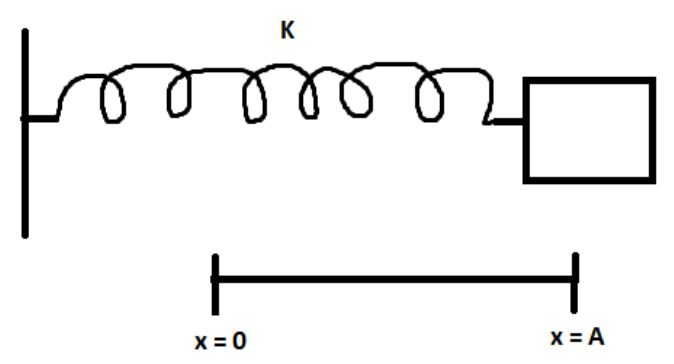
Find the mechanical energy of a block spring system with a spring constant of 1.3 N/cm and an amplitude of 2.4 cm.
Answer
561.6k+ views
Hint: A block spring system represents SHM. We can find its potential and kinetic energies in that context and then add them together to get an expression for mechanical energy, then the given values can be substituted to find its magnitude.
Mechanical energy (E) is the sum of potential (U) and kinetic (K) energies.
E = K + U.
Complete step by step answer:
The given block spring diagram can be represented diagrammatically as:

The block spring system presents an approximation of SHM (Simple harmonic motion), we can find the energies possessed in SHM.
The potential energy of this block spring system is given as:
$U = \dfrac{1}{2}K{x^2}$ and for SHM it can be represented as:
$\implies U = \dfrac{1}{2}K{x_m}^2{\cos ^2}\left( {\omega t + \phi } \right)$
The kinetic energy of this block spring system is given as:
$K = \dfrac{1}{2}m{v^2}$ and for SHM it can be represented as:
$\implies K = \dfrac{1}{2}K{x_m}^2{\sin ^2}\left( {\omega t + \phi } \right)$
Now, mechanical energy is the sum of potential and kinetic energy.
E = K + U
Substituting the values, we get:
$
E = \dfrac{1}{2}K{x_m}^2{\sin ^2}\left( {\omega t + \phi } \right) + U = \dfrac{1}{2}K{x_m}^2{\cos ^2}\left( {\omega t + \phi } \right) \\
\implies E = \dfrac{1}{2}K{x_m}^2\left[ {{{\sin }^2}\left( {\omega t + \phi } \right) + {{\cos }^2}\left( {\omega t + \phi } \right)} \right] \\
\implies E = \dfrac{1}{2}K{x_m}^2\left( {\because {{\sin }^2}\theta + {{\cos }^2}\theta } \right) \\
$
So the mechanical energy of the block spring system is given as:
$E = \dfrac{1}{2}K{x_m}^2$
The given values are:
Spring constant K = 1.3 N/cm or
Spring constant \[K = 1.3 \times {10^2}N/m\left( {\because 1m = {{10}^2}cm} \right)\]
Displacement ${x_m}$ = 2.4 cm [displacement is equal to the amplitude] or
Displacement ${x_m} = 0.024m$
$
\Rightarrow E = \dfrac{1}{2} \times 1.3 \times {10^2} \times {(0.024)^2}\left( {\because 1m = {{10}^2}cm} \right) \\
\implies E = 3.7 \times {10^{ - 2}} \\
$
Therefore, the mechanical energy of the block spring system is $3.7 \times {10^{ - 2}} J$.
Note:
A block mass system can either be horizontal or vertical, here we considered it to be horizontal.
We say that it possesses simple harmonic motion (SHM) over the assumption that Hooke’s law (F = -kx) is followed and no dissipating forces such as friction are present.
For conversion, remember that 1m is equal to 100 cm which can also be written as ${10^2}$ cm.
Mechanical energy (E) is the sum of potential (U) and kinetic (K) energies.
E = K + U.
Complete step by step answer:
The given block spring diagram can be represented diagrammatically as:

The block spring system presents an approximation of SHM (Simple harmonic motion), we can find the energies possessed in SHM.
The potential energy of this block spring system is given as:
$U = \dfrac{1}{2}K{x^2}$ and for SHM it can be represented as:
$\implies U = \dfrac{1}{2}K{x_m}^2{\cos ^2}\left( {\omega t + \phi } \right)$
The kinetic energy of this block spring system is given as:
$K = \dfrac{1}{2}m{v^2}$ and for SHM it can be represented as:
$\implies K = \dfrac{1}{2}K{x_m}^2{\sin ^2}\left( {\omega t + \phi } \right)$
Now, mechanical energy is the sum of potential and kinetic energy.
E = K + U
Substituting the values, we get:
$
E = \dfrac{1}{2}K{x_m}^2{\sin ^2}\left( {\omega t + \phi } \right) + U = \dfrac{1}{2}K{x_m}^2{\cos ^2}\left( {\omega t + \phi } \right) \\
\implies E = \dfrac{1}{2}K{x_m}^2\left[ {{{\sin }^2}\left( {\omega t + \phi } \right) + {{\cos }^2}\left( {\omega t + \phi } \right)} \right] \\
\implies E = \dfrac{1}{2}K{x_m}^2\left( {\because {{\sin }^2}\theta + {{\cos }^2}\theta } \right) \\
$
So the mechanical energy of the block spring system is given as:
$E = \dfrac{1}{2}K{x_m}^2$
The given values are:
Spring constant K = 1.3 N/cm or
Spring constant \[K = 1.3 \times {10^2}N/m\left( {\because 1m = {{10}^2}cm} \right)\]
Displacement ${x_m}$ = 2.4 cm [displacement is equal to the amplitude] or
Displacement ${x_m} = 0.024m$
$
\Rightarrow E = \dfrac{1}{2} \times 1.3 \times {10^2} \times {(0.024)^2}\left( {\because 1m = {{10}^2}cm} \right) \\
\implies E = 3.7 \times {10^{ - 2}} \\
$
Therefore, the mechanical energy of the block spring system is $3.7 \times {10^{ - 2}} J$.
Note:
A block mass system can either be horizontal or vertical, here we considered it to be horizontal.
We say that it possesses simple harmonic motion (SHM) over the assumption that Hooke’s law (F = -kx) is followed and no dissipating forces such as friction are present.
For conversion, remember that 1m is equal to 100 cm which can also be written as ${10^2}$ cm.
Recently Updated Pages
Master Class 11 Computer Science: Engaging Questions & Answers for Success

Master Class 11 Maths: Engaging Questions & Answers for Success

Master Class 11 Chemistry: Engaging Questions & Answers for Success

Master Class 11 Physics: Engaging Questions & Answers for Success

Why are manures considered better than fertilizers class 11 biology CBSE

Find the coordinates of the midpoint of the line segment class 11 maths CBSE

Trending doubts
What is meant by exothermic and endothermic reactions class 11 chemistry CBSE

10 examples of friction in our daily life

One Metric ton is equal to kg A 10000 B 1000 C 100 class 11 physics CBSE

Difference Between Prokaryotic Cells and Eukaryotic Cells

What are Quantum numbers Explain the quantum number class 11 chemistry CBSE

1 Quintal is equal to a 110 kg b 10 kg c 100kg d 1000 class 11 physics CBSE




